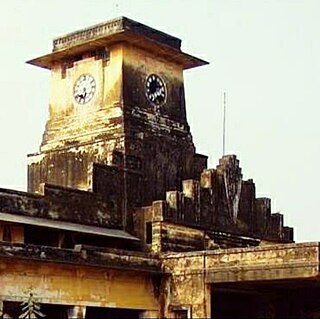Related Research Articles

The Central Provinces and Berar was a province of British India and later the Dominion of India which existed from 1903 to 1950. It was formed by the merger of the Central Provinces with the province of Berar, which was territory leased by the British from the Hyderabad State. Through an agreement signed on 5 November 1902, 6th Nizam Mahbub Ali Khan, Asaf Jah VI leased Berar permanently to the British for an annual payment of 25 lakhs rupees. Lord Curzon decided to merge Berar with the Central Provinces, and this was proclaimed on 17 September 1903.

Korea State, currently spelt as Koriya, was a princely state of the British Empire of India. After Indian independence in 1947, the ruler of Korea acceded to the Union of India on 1 January 1948, and Koriya was made part of Surguja District of Central Provinces and Berar province. In January 1950, "Central Provinces and Berar" province was renamed Madhya Pradesh state. After November 2000, Korea and the former princely state of Changbhakar became Koriya district of Chhattisgarh state.

Rewa State, also known as Rewah, was a Rajput princely state of India, surrounding its eponymous capital, the town of Rewa.

The Imperial Legislative Council (ILC) was the legislature of British India from 1861 to 1947. It was established under the Charter Act of 1853 by providing for the addition of 6 additional members to the Governor General Council for legislative purposes. Thus, the act separated the legislative and executive functions of the council and it was this body within the Governor General's Council which came to known as the Indian/Central Legislative Council. In 1861 it was renamed as Imperial Legislative Council and the strength was increased.

Bastar state was a princely state in India during the British Raj. It was founded in the early 14th century by Annamaraja, a brother of the last ruler of the Kakatiya dynasty, Prataparudra II.

The Bettiah Raj, also known as the Bettiah Empire, was the second-largest zamindari in the Bettiah region of Bihar, India. It generated annual land revenue rentals of more than 2 million rupees.

Alirajpur State was formerly a princely state of India, administratively under the Bhopawar Agency subdivision of the Central India Agency. The state covered an area of 2165 square kilometres, with a population of 50,185 in 1901 and its capital at Alirajpur. The average revenue of the state was Rs.100,000 in 1901.

The Jawhar State was a princely state in India. As a princely state, it became a part of Bombay Presidency during the British Raj. It was the only state belonging to the Thana Agency.

Raigarh was a princely state in India at the time of the British Raj. The state was ruled by a Gond dynasty of Gond clan.

Udaipur State was one of the princely states of India during the period of the British Raj. The town of Dharamjaigarh was the former state's capital.

Khairagarh State was one of the princely states of India during the period of the British Raj. Khairagarh town in Khairagarh-Chhuikhadan-Gandai district of Chhattisgarh was the capital of the state and the see of the Raja's residence.

Kharsawan State, also spelt Kharsua or kharaswan, (Odia:ଖରସୁଆଁ)was a princely state in India during the era of the British Raj. The state had a privy purse of 33,000 Rs.It was one of the Odia Princely states of India during the period of the British Raj and the major language spoken in the area is Odia.

Surguja State was one of the main princely states of Central India during the period of the British Raj, even though it was not entitled to any gun salute. Formerly it was placed under the Central India Agency, but in 1905 it was transferred to the Eastern States Agency.
Samthar State was a princely state established in 1735 by Ranjit Singh in India during the British Raj. The state was administered as part of the Bundelkhand Agency of Central India. The state was ruled by Bargujar Rajputs and was entitled to a 13 gun salute. Its capital, known then as Samshergarh, is located in a level plain in the Bundelkhand region crossed by the Pahuj and the Betwa Rivers.

Kanker State was one of the princely states of India during the period of the British Raj. Its last ruler signed the accession to the Indian Union in 1947.
The New Year Honours 1903, announced at the time as the Durbar Honours, were appointments to various orders and honours of the United Kingdom and British India. The list was announced on the day of the 1903 Delhi Durbar held to celebrate the succession of King Edward VII and Queen Alexandra as Emperor and Empress of India. The membership of the two Indian Orders were expanded to allow for all the new appointments.
The 1911 Delhi Durbar was held in December 1911 following the coronation in London in June of that year of King George V and Queen Mary. The King and Queen travelled to Delhi for the Durbar. For the occasion, the statutory limits of the membership of the Order of the Star of India and the Order of the Indian Empire were increased and many appointments were made to these and other orders. These honours were published in a supplement to the London Gazette dated 8 December 1911.

Bir Mitrodaya Singh Deo KCIE, was Maharaja of Sonepur from 1902 until his death in 1937.
Niladhar Singh Deo, known as Niladrinath Singh Deo, was Raja of Sonepur from 1841 until his death in 1891.
The Dhal dynasty was a dynasty that ruled the parts of the present-day Indian states of Jharkhand and West Bengal, known as the Rajas of Dhalbhum or Ghatshila. Their capital was located at Ghatshila in East Singhbhum district. Their rule lasted till the British era.
References
- 1 2 3 Memoranda on Native States in India, Together with a List of Independent Ruling Chiefs, Chiefs of Frontier States, and Other Notables with Their Proper Forms of Address. Calcutta: Superintendent Government Printing, India. 1911. p. 141.
- ↑ Vadivelu, A. (1915). The Ruling Chiefs, Nobles and Zamindars of India. G.C. Loganadham.
- ↑ Department, India Foreign and Political (1909). United Provinces, Oudh, Bengal, Central Provinces. Office of the Superintendent of Government Printing, India.
- ↑ Lethbridge, Sir Roper (1900). The Golden Book of India: A Genealogical and Biographical Dictionary of the Ruling Princes, Chiefs, Nobles, and Other Personages, Titled Or Decorated, of the Indian Empire, with an Appendix for Ceylon. S. Low, Marston & Company.
- 1 2 Who's who in India. Newul Kishore Press. 1911.
- ↑ Commons, Great Britain Parliament House of (1904). Parliamentary Papers: 1850-1908. H.M. Stationery Office.
- 1 2 Cotton, James Sutherland; Burn, Sir Richard; Meyer, Sir William Stevenson (1908). Imperial Gazetteer of India ... Clarendon Press.